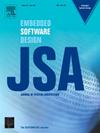GTA: Generating high-performance tensorized program with dual-task scheduling
IF 3.7
2区 计算机科学
Q1 COMPUTER SCIENCE, HARDWARE & ARCHITECTURE
引用次数: 0
Abstract
Generating high-performance tensorized programs for deep learning accelerators (DLAs) is crucial for ensuring the efficient execution of deep neural networks. But, producing such programs for different operators across various DLAs is notoriously challenging. Existing methods utilize hardware abstraction to represent acceleration intrinsics, enabling end-to-end automated exploration of the intrinsics mapping space. However, their limited search space and inefficient exploration strategies often result in suboptimal tensorized programs and significant search time overhead.
In this paper, we propose GTA, a framework designed to generate high-performance tensorized programs for DLAs. Unlike existing deep learning compilers, we first coordinate intrinsic-based mapping abstraction with rule-based program generation strategy, followed by the application of resource-constrained rules to eliminate ineffective tensor program candidates from the search space. Second, we employ a dual-task scheduling strategy to allocate tuning resources across multiple subgraphs of deep neural networks and their mapping candidates. As a result, GTA can find high-performance tensor programs that are outside the search space of existing state-of-the-art methods. Our experiments show that GTA achieves an average speedup of more than 1.88 over AMOS and 2.29 over Ansor on NVIDIA GPU with Tensor Core, as well as 1.49 over Ansor and 2.76 over PyTorch on CPU with AVX512.
GTA:生成具有双任务调度的高性能张化程序
为深度学习加速器(DLAs)生成高性能张化程序对于确保深度神经网络的高效执行至关重要。但是,为不同地区的不同运营商制作这样的程序是出了名的具有挑战性。现有方法利用硬件抽象来表示加速本质,从而实现对本质映射空间的端到端自动探索。然而,它们有限的搜索空间和低效的探索策略往往导致次优的张化规划和巨大的搜索时间开销。在本文中,我们提出了GTA,一个旨在为dla生成高性能张张化程序的框架。与现有的深度学习编译器不同,我们首先将基于内在的映射抽象与基于规则的程序生成策略相协调,然后应用资源约束规则从搜索空间中消除无效的张量程序候选。其次,我们采用双任务调度策略在深度神经网络的多个子图及其映射候选图之间分配调优资源。因此,GTA可以在现有最先进的方法的搜索空间之外找到高性能的张量程序。我们的实验表明,GTA在Tensor Core的NVIDIA GPU上比AMOS平均加速超过1.88倍,比Ansor平均加速超过2.29倍,在AVX512的CPU上比Ansor平均加速超过1.49倍,比PyTorch平均加速超过2.76倍。
本文章由计算机程序翻译,如有差异,请以英文原文为准。
求助全文
约1分钟内获得全文
求助全文
来源期刊

Journal of Systems Architecture
工程技术-计算机:硬件
CiteScore
8.70
自引率
15.60%
发文量
226
审稿时长
46 days
期刊介绍:
The Journal of Systems Architecture: Embedded Software Design (JSA) is a journal covering all design and architectural aspects related to embedded systems and software. It ranges from the microarchitecture level via the system software level up to the application-specific architecture level. Aspects such as real-time systems, operating systems, FPGA programming, programming languages, communications (limited to analysis and the software stack), mobile systems, parallel and distributed architectures as well as additional subjects in the computer and system architecture area will fall within the scope of this journal. Technology will not be a main focus, but its use and relevance to particular designs will be. Case studies are welcome but must contribute more than just a design for a particular piece of software.
Design automation of such systems including methodologies, techniques and tools for their design as well as novel designs of software components fall within the scope of this journal. Novel applications that use embedded systems are also central in this journal. While hardware is not a part of this journal hardware/software co-design methods that consider interplay between software and hardware components with and emphasis on software are also relevant here.
 求助内容:
求助内容: 应助结果提醒方式:
应助结果提醒方式:


